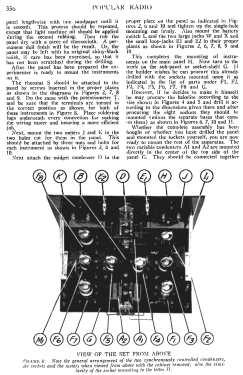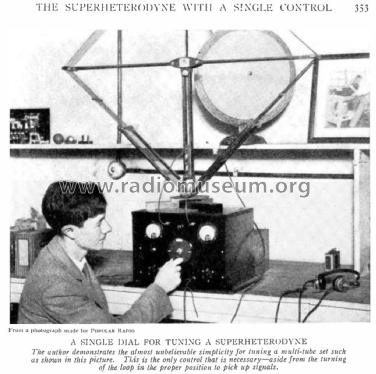McLaughlin's Single-Dial Superheterodyne
Popular Radio, Inc.; New York, NY
- Produttore / Marca
- Popular Radio, Inc.; New York, NY
- Anno
- 1925
- Categoria
- Kit, scatola di montaggio (parti sfuse e istruzioni o solo istruzioni di montaggio)
- Radiomuseum.org ID
- 361961
Clicca sulla miniatura dello schema per richiederlo come documento gratuito.
- Numero di tubi
- 8
- Principio generale
- Supereterodina (in generale)
- Gamme d'onda
- Solo onde medie (OM).
- Tensioni di funzionamento
- Batterie (di accumulatori e/o a secco) / 90, 6 Volt
- Altoparlante
- - Questo apparecchio richiede altoparlante/i esterno/i.
- Materiali
- Mobile in legno
- Radiomuseum.org
- Modello: McLaughlin's Single-Dial Superheterodyne - Popular Radio, Inc.; New York,
- Forma
- Soprammobile verticale (sviluppato in altezza; no cattedrale, sin decorazioni).
- Annotazioni
-
James Leo McLaughlin's Single-Dial Superheterodyne (October 1925, Popular Radio)
James Leo McLaughlin was a pioneering radio designer whose single-dial superheterodyne receiver, featured in the October 1925 issue of Popular Radio, marked a leap in radio technology. The superheterodyne principle—originally developed by Edwin Armstrong—had already transformed radio reception, but early designs were complex with multiple tuning controls. McLaughlin’s design solved this by introducing a true single-dial control, making high-performance radio accessible to average users.
Circuit Description and Technical Features
Simplicity and Accessibility:
McLaughlin’s superheterodyne was called “the most advanced of all the single-control developments” of its time. It was an eight-tube set, operable from a single dial “as easily and satisfactorily as the simplest crystal receiver.” The receiver could be assembled by anyone, even beginners, using only standard, widely available parts.Efficiency:
A key feature was its low power draw—only about 10 milliamperes of total plate current—ensuring long “B” battery life and economical operation.Single-Dial Tuning Mechanism:
The innovation lay in the tuning: two straight-line frequency variable condensers (one across the loop, one across the oscillator) were matched. Hence, the frequency difference between the oscillator and the signal stayed fixed, essential for superheterodyne operation. A small midget variable condenser shunted across the oscillator condenser allowed fine adjustment. Once set, the two main condensers operated together, enabling true single-dial control.Component Arrangement:
Instead of the usual row of eight tubes, McLaughlin arranged them in an exaggerated “H” shape for compactness and better circuit isolation:- Oscillator tube: Upper left of “H”
- First detector: Lower left
- Three RF tubes + second detector: Horizontal bar
- Two audio-frequency stages: Right vertical
- This layout allowed short, direct connections, reducing feedback and making the set more compact and visually appealing.
Intermediate Frequency and Transformers:
The intermediate gang-transformer (“super-multiformer”) was a high-wave RF unit, chosen for its ease of integration and optimal intermediate frequency operation. All transformers, coils, and fixed condensers were compactly mounted under the sub-panel.Performance:
The receiver was highly selective, delivered excellent audio, and could operate over a range exceeding 3,500 miles—covering the entire broadcast band. Despite its compact size, there was “no operating disadvantage at all,” and the set was praised for both performance and appearance.Legacy
McLaughlin’s single-dial superheterodyne became a milestone in radio design, proving advanced superheterodyne technology could be simple, efficient, and accessible, and paving the way for mass adoption of user-friendly radios.See 7-tube ERLA version imported to the UK.
- Bibliografia
- -- Original prospect or advert (Popular Radio Oct 1925, Pages 350 - 363..)
- Autore
- Modello inviato da Gary Cowans. Utilizzare "Proponi modifica" per inviare ulteriori dati.
- Altri modelli
-
In questo link sono elencati 1 modelli, di cui 1 con immagini e 1 con schemi.
Elenco delle radio e altri apparecchi della Popular Radio, Inc.; New York, NY
















